- Faculty News
- Student News
- Lab News
- Publications
- Meetings and Presentations
- Outreach
- Grants
- Announcements
- About This Newsletter
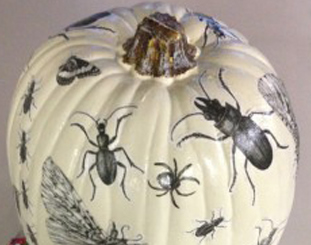
ABOVE: It is that time of year again, when Treater trickmaxamis (commonly known as trick-or-treaters) will be on the move again. Learn more about these organisms and their complex communication and social structure.
Congratulations to Dr. Jiri Hulcr for receiving the Richard Jones Outstanding New Faculty Research Award for 2016, which is one of the most prestigious awards offered by the UF/IFAS Dean for Research Office.

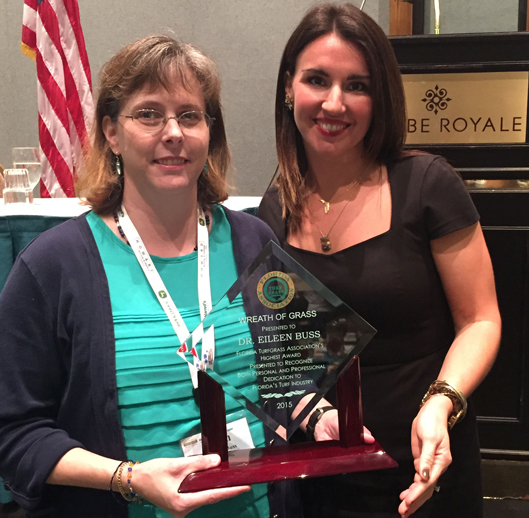
ABOVE: Congratulations to Dr. Eileen Buss for receiving the 2015 Wreath of Grass Award from the Florida Turfgrass Association. This award is the FTGA’s highest honor and pays tribute to individuals who have shown outstanding service to the FTGA and to the turfgrass industry.
 Are you receiving calls about holes in gas cans??? Camphor shot borers have shown up in north Florida and they are causing trouble! Read more about this interesting entomology problem in the UF/IFAS Jefferson County Extension Newsletter.
Are you receiving calls about holes in gas cans??? Camphor shot borers have shown up in north Florida and they are causing trouble! Read more about this interesting entomology problem in the UF/IFAS Jefferson County Extension Newsletter.
Last September, Luis F. Aristizábal (MS student in the Arthurs' lab) was invited by the Kohala Center and the Kona Coffee Farmers Association from Hawaii for training coffee farmers specifically in Pahala and Kona (Big Island, HI) on integrated pest management of coffee berry borer (CBB), the most serious insect pest on coffee plantation around the world. During the two week workshops, several lectures and field practices were conducted about biology, ecology, monitoring, cultural control practices, and use of biological control agents against the CBB. In addition, the USDA ARS from Hilo, HI invited Luis to deliver a seminar about this important insect pest, which is affecting the quality and production of Hawaiian specialty coffees since 2010.
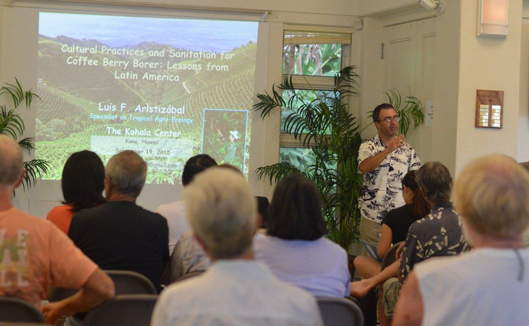
ABOVE: Luis F. Aristizábal speaking about coffee berry borer (CBB) strategies of control with coffee farmers from Kona, HI. More than 75 growers attended this lecture.
 Natasha M. Agramonte, a Ph.D. student of Dr. Uli Bernier and Dr. Jeff Bloomquist, presented a poster titled "Topical pyrethroid resistance and blood-feeding behavior in Puerto Rican Aedes aegypti and African Anopheles gambiae" at the 46th annual conference of the Society for Vector Ecology, which took place from September 27th - October 1st, 2015 in Albuquerque, New Mexico. This poster was coauthored by Aaron D. Gross, Daniel R. Swale, Jeffrey R. Bloomquist, and Ulrich R. Bernier.
Natasha M. Agramonte, a Ph.D. student of Dr. Uli Bernier and Dr. Jeff Bloomquist, presented a poster titled "Topical pyrethroid resistance and blood-feeding behavior in Puerto Rican Aedes aegypti and African Anopheles gambiae" at the 46th annual conference of the Society for Vector Ecology, which took place from September 27th - October 1st, 2015 in Albuquerque, New Mexico. This poster was coauthored by Aaron D. Gross, Daniel R. Swale, Jeffrey R. Bloomquist, and Ulrich R. Bernier.
Need to name that bug? A host of experts are available to help Floridians identify any insect or related arthropod. If a mystery creature has six or more legs, the UF Insect ID Lab is the place to call.
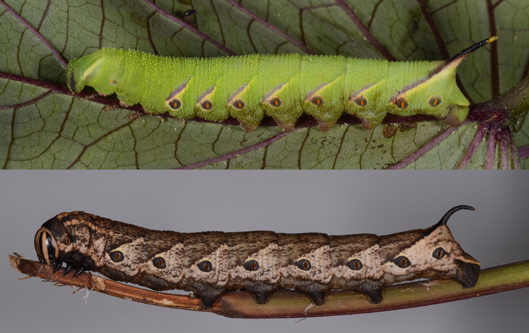
ABOVE: Dr. John Capinera brought in a nice caterpillar in September that he found feeding on sweet potato leaves. As you might guess, it is the sweet potato hornworm, Agrius cingulata. They commonly feed on morning glories, and are sometimes a pest on sweet potato. This specimen was green and 42 mm long on September 30 (above), and five days later was brown and 70 mm long (below). The adult is called the pink-spotted hawkmoth.
Lyle Buss is the UF/IFAS Insect ID Lab manager.
 Think it might be a nematode problem? The Nematode Assay Laboratory serves Florida and other states by providing nematode assays and expert advice regarding nematode management.
Think it might be a nematode problem? The Nematode Assay Laboratory serves Florida and other states by providing nematode assays and expert advice regarding nematode management.
The lab determines the types and numbers of plant-parasitic nematodes in soil and plant samples. Since January 2015, the lab processed a total of 2,400 extension samples submitted for diagnosis and advice. The lab also provides molecular identification of nematodes to the species level. Since January 2015, the lab processed more than 78 samples for molecular characterization of root-knot nematodes.
A new SEM microscope in ICBR brings nematode morphology to life. Graduate students in nematology took a recent trip to the UF Scanning Electron Microscope core facility located in the ICBR. This gave students an opportunity to image nematodes using the newest SEM SU 5000. This new lab is a satellite location of the UF core facilities located in the Microbiology and Cell Science Department. The main lab is also equipped with SEM scopes and TEM microscopes with cryo capability.
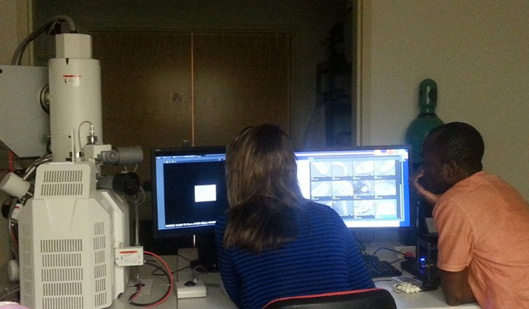
ABOVE: The new SEM machine delivers images of structures less than a µm with amazing clarity. As nematologists, we spend hours studying specimens with light microscopes. Seeing them with the clarity, detail, and high magnification of the SEM microscope allowed students to visualize structures normally invisible using light microscopy. As researchers here at UF, we are fortunate to have ready access to this technology that enriches our research and brings the nematodes’ microscopic world to life.
For more information on the Nematode Assay Laboratory please contact lab manager Dr. Tesfa Mengistu.
Abebe E, Mekete T, Seid A, Meressa B, Wondafrash M, Addis T, Getaneh G, Abate B. 2015. Research on plant-parasitic and entomopathogenic nematodes in Ethiopia: A review of current state and future direction. Nematology. 17: 741-753.
Ali AD, Harlow JL, Avery PB, Kumar V. 2015 Investigating the role of fungal entomopathogens in whitefly landscape IPM programs. Journal of Entomological Science. 50: 254-261.
Agramonte NM. 2015. Aristides Agramonte and the Yellow Fever Commission: A personal journey. Wing Beats. 26: 11-14.
Aristizábal LF, Ortiz AL, Quintero JC, López-Núñez JC, Toro H, Arthurs SP. 2015. Effect of Colombian strains of Steinernema colombiense (Rhabditida: Steinernematidae) and Heterorhabditis bacteriophora (Rhabditida: Heterorhabditidae) against Eurhizococcus colombianus (Hemiptera: Margarodidae) and Aeneolamia sp. (Hemiptera: Cercopidae). Florida Entomologist. 98: 981-983.
Liu B, Coy M, Wang J-J, Stelinski LL. 2015. The effects of host plant species on the detoxifying enzymes of the Asian citrus psyllid, Diaphorina citri (Hemiptera: Liviidae). Florida Entomologist. 98: 997-999.
Nation JL. 2015. Insect Physiology and Biochemistry, 3rd edition. CRC Press. 644 pages.
Sourakov A. 2015.Gynandromorphism in Automeris io (Lepidoptera: Saturniidae). News of Lepidopterists’ Society. 57: 118-129.
Tiwari S, Liu B, Mann RS, Killiny N, Stelinski LL. 2015. Effects of cold-acclimation, pathogen infection, and varying temperatures on insecticide susceptibility, feeding, and detoxifying enzyme levels of Diaphorina citri (Hemiptera: Liviidae). Florida Entomologist. 98: 870-879.
Willett D, Alborn, HT, Duncan LW, Stelinski LL. 2015. Social networks of educated nematodes. Scientific Reports. 5: 14388; doi: 10.1038/srep14388.
 New on Featured Creatures:
New on Featured Creatures:
Pineapple mealybug, Dysmicoccus brevipes (Cockerell). Authors: Ashley A. Egelie and Jennifer L. Gillett-Kaufman, University of Florida, Entomology and Nematology Department.
Tobacco thrips, Frankliniella fusca (Hinds). Authors: Ethan Carter, University of Florida, Agronomy Department, Jennifer L. Gillett-Kaufman, Entomology and Nematology Department.
Laurelcherry smoky moth, Neoprocris floridana Tarmann. Author: Donald W. Hall, Entomology and Nematology Department, University of Florida.
Do you have a favorite creature? Learn how to make it into a Featured Creatures!
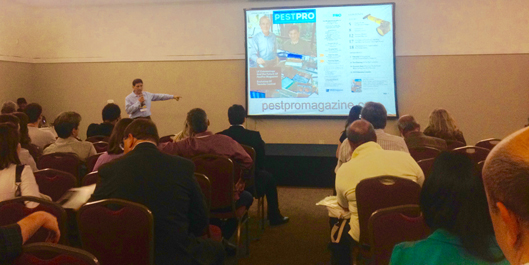
ABOVE: On September 10th, Dr. Roberto Pereira was an invited international speaker sponsored by BASF Brazil, at the sixth ECOPRAG, the biennial meeting of the Brazilian Association for Control of Vectors and Pests (ABCVP). In his presentation “Bed bug: pest that time took away, but brought back” Roberto highlighted work being developed at UF's Urban Entomology Laboratory, including information on PestPro Magazine is available online.
From the Outreach Coordinator
A big thank you to the students and faculty who volunteered for our September outreach events.
- 8 September- Starke Christian School- Chris Holderman
- 15 September- CALS Kickoff- Stefani Harrison, Sam Pass, Gabby Milanes, Cindy Sigler, Keith Gerber, Dr. Rebecca Baldwin
- 18 September- Micah Homeschool tours- Dale Halbritter, Shari Linn, WinDi Sanchez, Erin Powell, Patrick Riggs
- 19 September- Butterfly Fest- WinDi Sanchez, Michael Gonzalez, Shari Linn, Diana Garcia, Amelia Oliva Quevedo, Erin Powell
- 26 September- Bug Zoo at TailGator- Gabby Milanes, Stefani Harrison, Sam Pass, Andre Szejner, (Prep)- Paul Joseph, Dale Halbritter
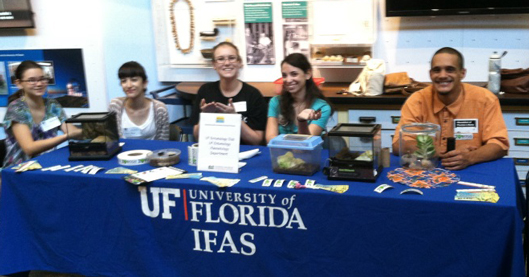
ABOVE: Diana Garcia, Amelia Quevedo, WinDi Sanchez, Shari Linn, and Michael Gonzalez at the FLMNH’s 2015 Butterfly Fest.
The live critters are always a hit with children and adults alike. The critters are available for you to check out should you be leading an outreach event. We have doubles of our most popular critters, as well as various native insect species depending on the time of year. We have large wood and Plexiglas cages for viewing our native orb weaving spiders. There is one travel cage and one larger static cage. Please be sure to contact us and review the protocol on transporting and handling the critters if you are not already familiar with it. If you lead an outreach, be sure to fill out a documentation form so your event can be included in the newsletter and we can log all outreach events.
If you have any questions, please email me.
Thank you — Erin Powell, Outreach Coordinator.
If you would like to schedule an event or have any outreach questions, go to the Outreach pages on our Bug Club website and contact us.
 Getting social!
Getting social!
We have several social media sites for the Entomology & Nematology Department. To make them easily searchable, all three (YouTube, Facebook and Twitter) have the same page name: UFEntomology. Please share these links with past students or colleagues who may have an interest in departmental activities.
Virni Mattson, our grants specialist, reports that from July1st to September 30th our external funding for all Entomology & Nematology faculty (in Gainesville and at RECs) was $4,196,763.94. This is for 57 new awards and does not reflect money returned by PIs for project reductions.
 Dr. Barry Alto with Co-PIs Dr. Scott Michael and Dr. Sharon Isern from Florida Gulf Coast University were awarded $85,469 from FDACS for their project- Controlling dengue in Florida: Assessment of novel vaccines in mosquito vectors.
Dr. Barry Alto with Co-PIs Dr. Scott Michael and Dr. Sharon Isern from Florida Gulf Coast University were awarded $85,469 from FDACS for their project- Controlling dengue in Florida: Assessment of novel vaccines in mosquito vectors.
Dr. Barry Alto with Co-PI Dr. L. Philip Lounibos were awarded $79,702 from FDACS for their project – Risk prediction of chikungunya virus emergence in Florida temperatures.
Our forest entomologist Dr. Jiri Hulcr is pleased to invite you to the Frontiers in Forest Health seminar, organized by the Emerging Threats to Forests Research Group of which Jiri is a founding member. The goal of the seminar is to bring federal-level administrators and decision-makers to our campus in order to facilitate communication between academics, regulators, funders, and practitioners with respect to sustaining our Nation’s forests.
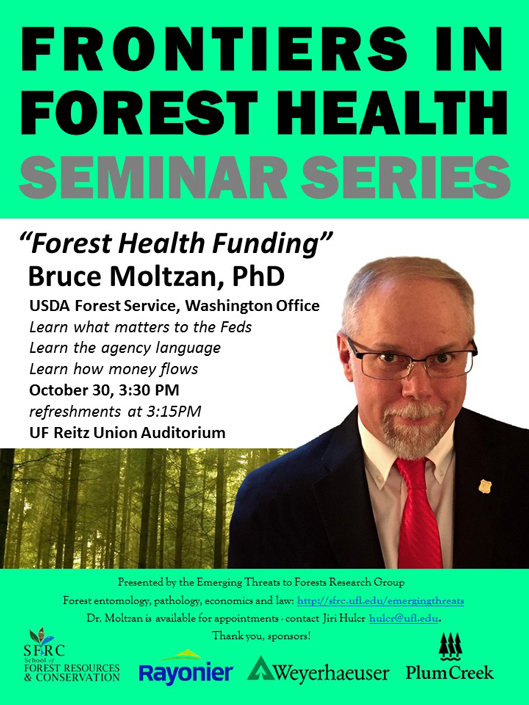
ABOVE: Dr. Bruce Moltzan, chief pathologist for the USDA Forest Health Protection, will explain how new research gets incorporated into decision-making, and will illuminate the evolution of relationships between agencies that are protecting forests from emerging threats.
When: October 30th, 2015. Refreshments at 3:15 PM, talk at 3:30 PM
Where: The Reitz Union Auditorium
We like to share news when it happens using our social media outlets: Twitter, Facebook and YouTube. Follow us on these sites for daily updates! When you send news, we will post it on one or more of these sites and again in the monthly newsletter. Please be sure you have permission from people in photographs you submit for publication.
UF-Bugnews-L listserv subscribers receive notices when issues are posted. Our home page has instructions for subscribing and unsubscribing.
Special thanks to Shari Linn and Nancy Sanders, who reviewed the newsletter for errors, and to Jane Medley and Don Wasik, who built the web page design.